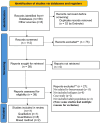Risk factors for poor bereavement outcomes and the support needs of adult bereaved refugees within the psychosocial-cultural concept of personhood: a systematic review
- PMID: 40376057
- PMCID: PMC12078022
- DOI: 10.3389/fpubh.2025.1517237
Risk factors for poor bereavement outcomes and the support needs of adult bereaved refugees within the psychosocial-cultural concept of personhood: a systematic review
Abstract
Background: The majority of refugees are exposed to trauma and multiple deaths and often face difficulties in coping with the death of someone close to them. This review aimed to systematically synthesize evidence regarding the risk factors associated with poor bereavement outcomes and the support needs of refugees during bereavement, using the ring theory of personhood as a guiding framework to inform service provision and policy development.
Methods: A systematic review was conducted using five citation databases (PsycINFO, CINAHL, SocINDEX, MEDLINE, and Web of Science), along with gray literature sources, to explore the bereavement support needs of refugees worldwide. The review followed the ring theory of personhood framework. A standardized data extraction tool (34) was used to analyse studies that included adult refugees who had experienced the death of a family member/friend. Two reviewers independently assessed the quality of the included studies to reduce bias. Due to the heterogeneity across the included studies, a narrative synthesis was conducted independently by two reviewers, with consensus reached on the final analysis.
Results: A total of 11 studies (eight quantitative, two mixed-methods, and one qualitative) were eligible for inclusion, representing a combined sample of 3,053 refugees. Across the rings of personhood, various risk factors related to bereavement were identified, including female sex, age, comorbidities, cultural and religious beliefs/values, and social factors. The findings indicate that refugees would benefit from culturally sensitive diagnostic tools for the early detection of grief symptoms, along with psycho-socio-cultural bereavement support interventions. Such interventions could enhance healthcare providers' understanding of refugees' perspectives, values, and preferences, thereby improving the quality of care provided.
Conclusion: This review identified a wide range of culturally sensitive assessments and support needs for bereaved refugees. A personalized approach to bereavement assessment and care is recommended to facilitate a more comprehensive and existential understanding of bereavement and grief in research, clinical practice, policymaking, and community-based support systems. Further research is warranted to examine the long-term effects of bereavement on refugees' mental health and to explore strategies for providing sustained support throughout the refugee journey.
Systematic review registration: https://www.crd.york.ac.uk/PROSPERO/view/CRD42022370126, Identifier CRD42022370126.
Keywords: bereavement; needs; personhood; refugee; risk factors.
Copyright © 2025 Dönmez, Seckin and Bailey.
Conflict of interest statement
The authors declare that the research was conducted in the absence of any commercial or financial relationships that could be construed as a potential conflict of interest.
Figures
Similar articles
-
Impacts of suicide bereavement on men: a systematic review.Front Public Health. 2024 Apr 9;12:1372974. doi: 10.3389/fpubh.2024.1372974. eCollection 2024. Front Public Health. 2024. PMID: 38655522 Free PMC article.
-
The impacts and effectiveness of support for people bereaved through advanced illness: A systematic review and thematic synthesis.Palliat Med. 2020 Jul;34(7):871-888. doi: 10.1177/0269216320920533. Epub 2020 May 18. Palliat Med. 2020. PMID: 32419630 Free PMC article.
-
Parental bereavement - impact of death of neonates and children under 12 years on personhood of parents: a systematic scoping review.BMC Palliat Care. 2021 Sep 4;20(1):136. doi: 10.1186/s12904-021-00831-1. BMC Palliat Care. 2021. PMID: 34481491 Free PMC article.
-
What elements of a systems' approach to bereavement are most effective in times of mass bereavement? A narrative systematic review with lessons for COVID-19.Palliat Med. 2020 Oct;34(9):1165-1181. doi: 10.1177/0269216320946273. Epub 2020 Jul 31. Palliat Med. 2020. PMID: 32736489 Free PMC article.
-
A systematic review of studies describing the influence of informal social support on psychological wellbeing in people bereaved by sudden or violent causes of death.BMC Psychiatry. 2020 May 29;20(1):265. doi: 10.1186/s12888-020-02639-4. BMC Psychiatry. 2020. PMID: 32471407 Free PMC article.
References
-
- UNHCR . (2023) Global forced displacement in 2023. Available online at: https://www.unhcr.org/refugee-statistics (Accessed December 5, 2023).
-
- Kokou-Kpolou CK, Moukouta CS, Masson J, Bernoussi A, Cénat JM, Bacqué M-F. Correlates of grief-related disorders and mental health outcomes among adult refugees exposed to trauma and bereavement: a systematic review and future research directions. J Affect Disord. (2020) 267:171–84. doi: 10.1016/j.jad.2020.02.026, PMID: - DOI - PubMed
-
- Parkes CM. Bereavement In: Parkes CM, editor. Social problems and mental health. New York: Routledge; (2022). 19–21.
Publication types
MeSH terms
LinkOut - more resources
Full Text Sources
Medical




